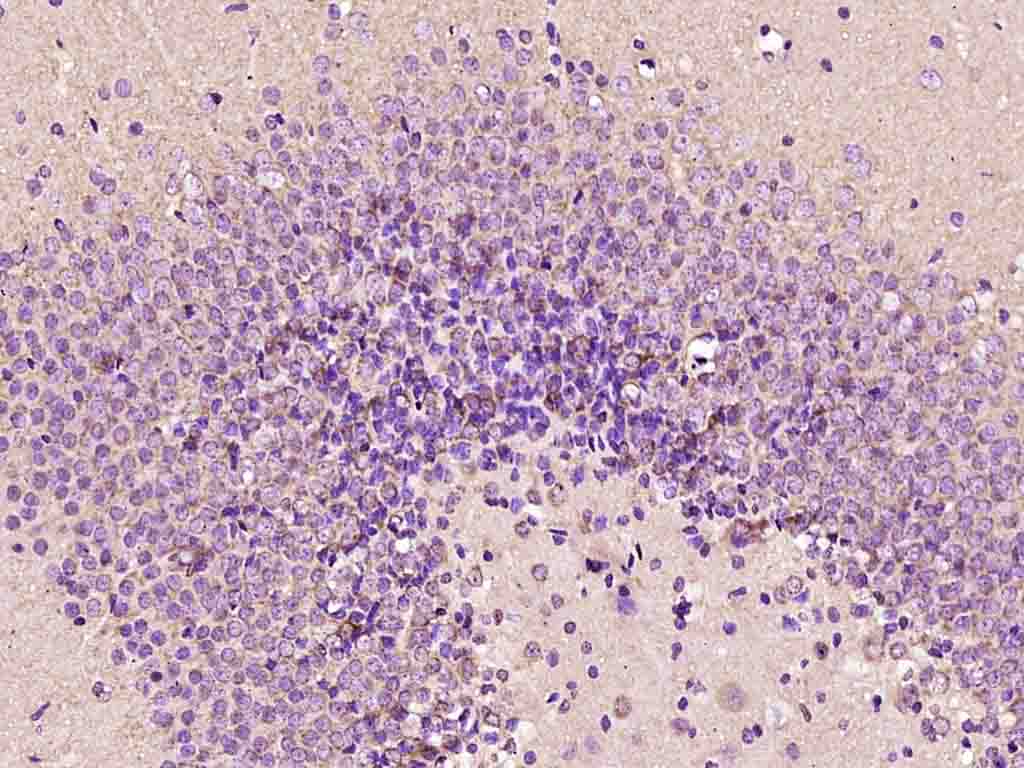
Rabbit Anti-phospho-Ataxin 1 (Ser775)antibody
Ataxin 1 (phospho S775); ATXN1; ATX1; D6S504E; SCA1; Ataxin-1; Spinocerebellar ataxia type 1; ATX1_HUMAN.
View History [Clear]
Details
Product Name phospho-Ataxin 1 (Ser775) Chinese Name 磷酸化脊髓小脑失调症蛋白1抗体 Alias Ataxin 1 (phospho S775); ATXN1; ATX1; D6S504E; SCA1; Ataxin-1; Spinocerebellar ataxia type 1; ATX1_HUMAN. Product Type Phosphorylated anti Research Area Cell biology immunology Chromatin and nuclear signals Neurobiology Signal transduction Apoptosis transcriptional regulatory factor Immunogen Species Rabbit Clonality Polyclonal React Species Rat, (predicted: Human, Mouse, Dog, Pig, Cow, Horse, Rabbit, ) Applications ELISA=1:5000-10000 IHC-P=1:100-500 IHC-F=1:100-500 ICC=1:100-500 IF=1:100-500 (Paraffin sections need antigen repair)
not yet tested in other applications.
optimal dilutions/concentrations should be determined by the end user.Theoretical molecular weight 90kDa Cellular localization The nucleus cytoplasmic Form Liquid Concentration 1mg/ml immunogen KLH conjugated Synthesised phosphopeptide derived from human Ataxin-1 around the phosphorylation site of Ser775: RW(p-S)AP Lsotype IgG Purification affinity purified by Protein A Buffer Solution 0.01M TBS(pH7.4) with 1% BSA, 0.03% Proclin300 and 50% Glycerol. Storage Shipped at 4℃. Store at -20 °C for one year. Avoid repeated freeze/thaw cycles. Attention This product as supplied is intended for research use only, not for use in human, therapeutic or diagnostic applications. PubMed PubMed Product Detail The autosomal dominant cerebellar ataxias (ADCA) are a heterogeneous group of neurodegenerative disorders characterized by progressive degeneration of the cerebellum, brain stem and spinal cord. Clinically, ADCA has been divided into three groups: ADCA types I-III. ADCAI is genetically heterogeneous, with five genetic loci, designated spinocerebellar ataxia (SCA) 1, 2, 3, 4 and 6, being assigned to five different chromosomes. ADCAII, which always presents with retinal degeneration (SCA7), and ADCAIII often referred to as the `pure' cerebellar syndrome (SCA5), are most likely homogeneous disorders. Several SCA genes have been cloned and shown to contain CAG repeats in their coding regions. ADCA is caused by the expansion of the CAG repeats, producing an elongated polyglutamine tract in the corresponding protein. The expanded repeats are variable in size and unstable, usually increasing in size when transmitted to successive generations. The function of the ataxins is not known. This locus has been mapped to chromosome 6, and it has been determined that the diseased allele contains41-81 CAG repeats, compared to 6-39 in the normal allele, and is associated with spinocerebellar ataxia type 1 (SCA1). At least two transcript variants encoding the same protein have been found for this gene. [provided by RefSeq].
Function:
Chromatin-binding factor that repress Notch signaling in the absence of Notch intracellular domain by acting as a CBF1 corepressor. Binds to the HEY promoter and might assist, along with NCOR2, RBPJ-mediated repression. Binds RNA in vitro. May be involved in RNA metabolism. The expansion of the polyglutamine tract may alter this function.
Subunit:
Homooligomer. Interacts with CIC. Interacts with ANP32A, PQBP1, UBQLN4, ATXN1L, USP7 and ZNF804A. Directly interacts with RBPJ; this interaction is disrupted in the presence of Notch intracellular domain. Competes with ATXN1L for RBPJ-binding.
Subcellular Location:
Cytoplasm. Nucleus. Note=Colocalizes with USP7 in the nucleus.
Tissue Specificity:
Widely expressed throughout the body.
Post-translational modifications:
Phosphorylation at Ser-775 increases the pathogenicity of proteins with an expanded polyglutamine tract.
Sumoylation is dependent on nuclear localization and phosphorylation at Ser-775. It is reduced in the presence of an expanded polyglutamine tract.
DISEASE:
Spinocerebellar ataxia 1 (SCA1) [MIM:164400]: Spinocerebellar ataxia is a clinically and genetically heterogeneous group of cerebellar disorders. Patients show progressive incoordination of gait and often poor coordination of hands, speech and eye movements, due to cerebellum degeneration with variable involvement of the brainstem and spinal cord. SCA1 belongs to the autosomal dominant cerebellar ataxias type I (ADCA I) which are characterized by cerebellar ataxia in combination with additional clinical features like optic atrophy, ophthalmoplegia, bulbar and extrapyramidal signs, peripheral neuropathy and dementia. SCA1 is caused by expansion of a CAG repeat in the coding region of ATXN1. Longer expansions result in earlier onset and more severe clinical manifestations of the disease. Note=The disease is caused by mutations affecting the gene represented in this entry.
Similarity:
Belongs to the ATXN1 family.
Contains 1 AXH domain.
SWISS:
P54253
Gene ID:
6310
Database links:Entrez Gene: 6310 Human
Entrez Gene: 20238 Mouse
Omim: 601556 Human
SwissProt: P54253 Human
SwissProt: P54254 Mouse
Unigene: 434961 Human
Unigene: 342683 Mouse
Unigene: 342686 Mouse
Unigene: 88438 Rat
Product Picture
Bought notes(bought amounts latest0)
No one bought this product
User Comment(Total0User Comment Num)
- No comment



 +86 571 56623320
+86 571 56623320
 +86 18668110335
+86 18668110335

